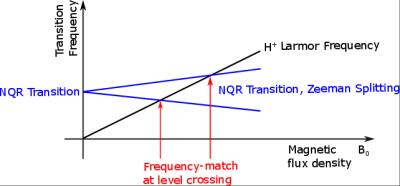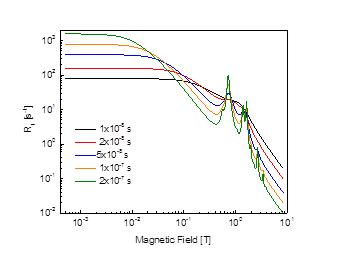3058
Extrinsic MRI contrast agents based on nuclear quadrupole enhanced relaxation: Principle, requirements and characterization of promising compounds1Institute of Medical Engineering, Graz University of Technology, Graz, Austria, 2Faculty of Mathematics and Computer Science, University of Warmia and Mazury in Olsztyn, Poland, 3Department of Chemistry, Umeå universitet, Sweden, 4Institute of Inorganic Chemistry, Graz University of Technology, Graz, Austria, 5Institute for Chemistry and Technology of Materials, Graz University of Technology, Graz, Austria
Synopsis
Quadrupole Relaxation Enhancement is a quantum mechanical effect that can be exploited to create a new generation of extrinsic contrast agents for usage in MRI. In this work we have investigated the physical requirements of such contrast agents have to meet to be useful. Based on our findings concerning nuclear quadrupole resonance-properties, spin relaxation behavior and toxicity we suggest a variety of 209Bi-aryl compounds. The sensitivity of these compounds onto chemical or magnetic field changes equip them with smart properties such as on/off switching of the contrast or molecular imaging.
Purpose
So far Quadrupol Relaxation Enhancement (QRE)1 has not been exploited for designing extrinsic MRI contrast agents, although there is high potential of this effect for designing smart molecular probes, the contrast of which can be switched by both magnetic fields as well as chemical reactions which change the bonding structure of the contrast agent. In this work we investigated the basic physical properties of potential QRE compounds based on 209Bi.Theory
Dipolar coupling of water protons to high spin nuclei possessing Nuclear Quadrupole Resonance2,3(NQR) transitions can lead to a significant speed up of T1- proton relaxation.1,4 This effect, which is referred to as QRE, can be used to enhance the T1 contrast in Magnetic Resonance Imaging (MRI).5 The mechanism works as follows: Nuclei with spin quantum number I>1/2 possess an electrical quadrupole moment (QM) and interact with the gradient of the electric field (EFG) generated by the closely-surrounding electron orbitals, including the bonding electrons. Depending on I and the magnetic flux density, quadrupolar nuclei (QN) show energy level splitting in addition to the zero field spectrum and thus transitions at frequencies which are determined by the QM, the EFG and on the magnitude as well as the orientation of the magnetic field (see figure 1). The quadrupolar spin subsystem acts as a kind of magnetization sink for the proton ½ spin. When the transition frequencies of both the proton and QN match (see level crossing in figure 1), as well as when dynamic and spatial conditions are in the right range, an energy (magnetization) transfer from the protons to the QN will speed up the proton spin relaxation.Methods
A model for the prediction of the QRE for the QN spin quantum number of I= 9/2 has been developed profiting from1. It allows for the maximization of the QRE by tuning the following pivotal parameters: NQR transition frequencies, rotational correlation time of the spin system and correlation time of the fluctuations of the EFG which determine the relaxation rates of the QN.
For pre-selecting good candidate molecules a number of 209Bi containing compounds were characterized concerning their relaxation times T1 and T2 and the NQR-transitions frequencies as well as their temperature dependence at 37 °C. 209Bi was selected as QN because of its I= 9/2 which gives rise to a high number of NQR transition frequencies. An external magnetic flux density yields considerable additional splitting because of the gyromagnetic ratio of 6.84 MHz/T. Experiments were carried out with a zero-field NQR-pulse-spectrometers (Tecmag, “Scout”) operated with commercial as well as custom-built coils6 using standard sequences (Spin Echo, Inversion Recovery).
Results and Discussion
On the basis of simulations of the QRE effect,1 a “guideline” for required properties for the compounds concerning particle size and EFG fluctuations has been developed. The importance of the rotational correlation time (and so the particle size) between QN and proton in order to generate the desired QRE peaks is shown in figure 2.
209Bi-aryl compounds derived from triphenylbismuth (BiPh3) with comparatively low toxicity were identified as promising because their EFG causes transition frequencies close to the Larmor frequency of protons at 3 T. Moreover the transitions can be easily altered by substituting hydrogen by different groups at different sites of the phenyl rings. In particular we investigated BiPh3 and derivates with flourine, oxymethyl and dimethylamide groups at the para position of all three phenyl rings as well as one structurally different compound with a coordination number of five, i.e. triphenylbismuthdichloride.
Changing the substituents causes frequency shifts of several MHz, which demonstrates the potential for tuning the substance to the desired Larmor frequency. The relaxation times span a wide range from 50 μs to >1000 μs for T1, and from 20 μs to almost 500 μs for T2. The most important data are depicted in figure 3.
Conclusion
We identified five promising Bi-aryl compounds as potential candidates to take advantage of the QRE effect as extrinsic contrast agent in clinical MRI’s. The NQR-spectrum, and consequently the QRE effect, is sensitive to chemical and structural alterations of the molecule and to the strength of an externally applied magnetic field. We see great potential for applications of this frequency selective contrast effect: Molecular imaging or switching on/off the contrast effect by shifting the B0 field is imaginable.Acknowledgements
This project has received funding from the European Union’s Horizon 2020 research and innovation programme under grant agreement No 665172References
1. D. Kruk, A. Kubica, W. Masierak, A. F. Privalov, M. Wojciechowski, W. Medycki, Quadrupole relaxation enhancement—application to molecular crystals, Solid State Nuclear Magnetic Resonance, 40 (2011) 114-120, ISSN 0926-2040
2. T. P. Das, E. L. Hahn: Nuclear quadrupole resonance spectroscopy, Solid state physics. Supplement 1, Academic Press Inc. (1958)
3. D. Possa, A. C. Gaudio, J.C.C. Freitas, Numerical simulation of NQR/NMR: Applications in quantum computing , Journal of Magnetic Resonance, 209 (2011) 250-260, ISSN 1090-7807
4. G Voigt, R Kimmich, Quadrupolar dip in proton relaxation dispersion of poly(vinyl chloride), Journal of Magnetic Resonance (1969), Volume 24, Issue 1, October 1976, Pages 149-154
5. D. J. Lurie, S. Aime, S. Baroni, N. A. Booth, L. M. Broche, C.-H. Choi, G. R. Davies, S. Ismail, D. Ó hÓgáin, and K. J. Pine, Fast field-cycling magnetic resonance imaging,Comptes Rendus Phys., Bd. 11, Nr. 2, S. 136–148, (2010)
6. Hermann Scharfetter. (2016). An electronically
tuned wideband probehead for NQR spectroscopy in the VHF range. Journal of
Magnetic Resonance, 271(October 2016), 90–98.
Figures


